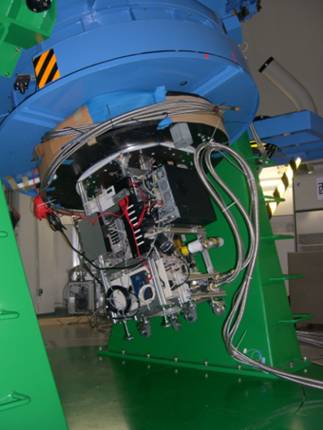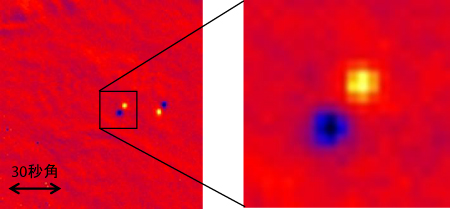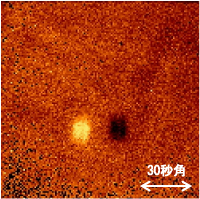May 2007: First light observations of MAX38 at the Higashi-Hiroshima Astronomical Observatory
Issued on 17 December, 2008
The mid-infrared camera MAX38 successfully saw the first N-band (10 micron) light
on the Kanata telescope at the Higashi-Hiroshima Astronomical Observatory. On-sky
performances were evaluated based on the astronomical data. A newly developed cold
chopping system installed in MAX38 worked very well for the astronomical
# Members : Miyata, Sako, Nakamura, and Doi
# Date: June 2-7, 2007

| |
fig1: MAX38 attached on the Cassegrain focus of the Kanata 1.5m telescope
|
1. On-sky performances of MAX38
We carried out PV observations to evaluate the on-sky performance of MAX38.
- Optical performance
- Point source image with the FWHM of 1.5arcsec at 8.9 micron was successfully obtained. This corresponds to the diffraction limited performance of the 1.5m telescope.
- No distortion and no vignetting were confirmed.
- No degradation of the image quality with tilting the instrument were confirmed.
- Sensitivity
- The sensitivity of 1sig1sec at 8.9 micron was estimated to be 4Jy. This is almost consistent with the designed value.
- Inhomogeneity of the sensitivity within the field of view was sufficiently small.
- Vacuum and Cooling
- High vacuum (10-6torr以下)・and very low temperature (7K以下) was stably kept during observations.
- Vibration of a GM cooler was not affected on the image quality.
- Mechanics and Telescope I/F
- A rotation mechanism of the filter wheel in the cold optics had some minor problems.
- Attachment of MAX38 to the Kanata telescope works well.
- Cold Chopping System
- Observations with using the cold chopping system were successfully carried out for the first time.
- Closed loop control for stabilizing stellar images during the chopping cycles worked well.
- Time variations of the background were accurately subtracted with the cold chopper even in the worse weather condition in Japan.
- Much larger throw of the chopping is needed for observing extended objects.
- The control loop sometimes became unstable at some tilting angle of the instrument.
2. First light images
This figure is a typical MAX38 data obtained in this observing run. Both high
speed chopping (∼ 5Hz) with the cold chopper and slow (every a few 10sec)
nodding of the telescope were conducted. Therefore a reduced data shows four
images, two are positive and two are negative.

| |
fig2: (Left) A mid infrared image of a nova Sco 2007a at 8.9 micron obtained by MAX38.
Chop-and-nodding technique was conducted. (Right) An enlarged view of a pair of
the chopping. There is an interval of 4.3 arcsec between two images.
|
The maximum throw of the current chopper is 5 arcsec. This is a strong limit for
observing extended object larger than 5 arcsec. Improvements of the chopping
throw are essentially needed.
In this observing run extended objects were observed without chopping (nod-
only). We note that it caused serious degradation of the sensitivity.

| |
fig3: A sample of the extended object obtained by nod-only observations of MAX38. This
is an image of a planetary nebula NGC7027 at 8.9 micron. Warm dust heated by the
central star was clearly seen.
|
(Sako Shigeyuki)
|




